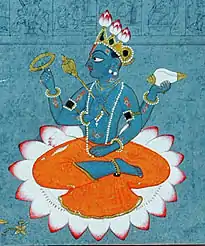Narayana
Narayana (Sanskrit: नारायण, IAST: Nārāyaṇa) is known as one who is in yogic slumber on the celestial waters, referring to Lord Maha Vishnu. He is also known as Purushottama and is considered the Supreme being in Vaishnavism.
| Narayana | |
|---|---|
Supreme Being, Absolute Truth, Ishvara | |
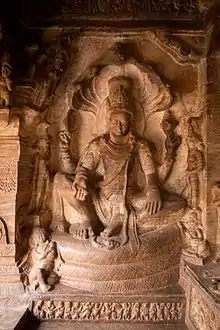 A depiction of Lord Narayana at Badami cave temples | |
| Devanagari | नारायण |
| Sanskrit transliteration | Nārāyaṇa or Naarayana नारायण The Ultimate truth Supreme Being, Absolute truth, Para brahman, ultimate reality of godhead |
| Affiliation | Adi Narayana |
| Abode | Vaikuntha |
| Mantra | "ॐ नमो नारायणाय" "Om Namo Nārāyaṇaya" Obeisance to Narayana Or, "Om brohmanodevayo gobrahmanhitayo cha, Jagadhitayo krishnayo gobindayo namo namaha" |
| Weapon | Sankh, Chakra, Gada, Padma |
| Mount | Garuda |
| Texts | Vedas |
| Consort | Lakshmi |
| Part of a series on |
| Vaishnavism |
|---|
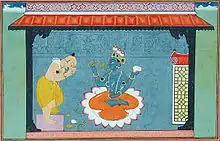 |
|
|
According to the Bhagavad Gita, he is also the "Guru of the Universe". The Bhagavata Purana declares Narayana as the Supreme Personality of Godhead who engages in the creation of 14 worlds within the universe Brahma who is Deity of rajas guna, himself sustains, maintains and preserves the universe as Vishnu by accepting sattva guna. Narayana himself annihilates the universe at the end of maha-kalpa as Kalagni Rudra who is presiding deity of tamas guna.
According to the Bhagavata Purana, Purusha Sukta, Narayana Sukta, and Narayana Upanishad from the Vedas, he is the ultimate soul.
According to Madhvacharya, Narayana is one of the five Vyuhas of Vishnu, which are cosmic emanations of God in contrast to his incarnate avatars. Bryant, Edwin F., Krishna: a Sourcebook. p. 359 "Madhvacharya separates Vishnu's manifestations into two groups: Vishnu's vyuhas (emanations) and His avataras (incarnations). The Vyuhas have their basis in the Pancharatras, a sectarian text that was accepted as authoritative by both the Vishishtadvaita and Dvaita schools of Vedanta. They are mechanisms by which the universe is ordered, was created, and evolves. According to Madhvacharya, Vishnu has five vyuhas, named Narayana, Vasudeva, Sankarshana, Pradyumna and Aniruddha, which evolve one after the other in the development of the universe.
Nomenclature and Etymology
In the Vedas, Narayana is essentially the supreme force and/or essence of all: 'Nārāyaṇa parabrahman tatvam Nārāyaṇa paraha'.[1] Narayan Aiyangar states the meaning of the Sanskrit word 'Narayana' can be traced back to the Laws of Manu (also known as the Manu-smriti, a Dharmaśāstra text),[2] which states:
The waters are called narah, (for) the waters are, indeed, the offspring of Nara; as they were his first residence (ayana), he thence is named Narayana.
— Chapter 1, Verse 10[3]
This definition is used throughout Vedic literature such as the Mahabharata and Vishnu Purana.[4][2] 'Narayana' is also defined as the 'son of the primeval man',[5] and 'Supreme Being who is the foundation of all men'.[6]
Description

In the Vedas and Puranas, Lord Narayana is described as having the divine blue colour of water-filled clouds, four-armed, holding a padma (lotus flower), Kaumodaki (mace), Panchajanya shankha (conch) and the Sudarshana Chakra (discus).
Hinduism
As stated in the epic itihāsa, the Mahabharata:
I am Narayana, the Source of all things, the Eternal, the Unchangeable. I am the Creator of all things, and the Destroyer also of all. I am Vishnu, I am Brahma and I am Sankra, the chief of the gods. I am king Vaisravana, and I am Yama, the lord of the deceased spirits. I am Siva, I am Soma, and I am Kasyapa the lord of the created things. And, O best of regenerate ones, I am he called Dhatri, and he also that is called Vidhatri, and I am Sacrifice embodied. Fire is my mouth, the earth my feet, and the Sun and the Moon are my eyes; the Heaven is the crown of my head, the firmament and the cardinal points are my ears; the waters are born of my sweat. Space with the cardinal points are my body, and the Air is my mind...
...And, O Brahmana, whatever is obtained by men by the practice of truth, charity, ascetic austerities, and peace and harmlessness towards all creatures, and such other handsome deeds, is obtained because of my arrangements. Governed by my ordinance, men wander within my body, their senses overwhelmed by me. They move not according to their will but as they are moved by me.— Mahabharata (translated by Kisari Mohan Ganguli, 1883-1896), Book 3, Varna Parva, Chapter CLXXXVIII (188)[4]
In the Mahabharata, Krishna is also synonymous with Narayana and Arjuna is referred to as Nara.[9] The epic identifies them both in plural 'Krishnas', or as part incarnations of the earlier incarnations of Vishnu, recalling their mystical identity as Nara-Narayana.[10]
Narayana is also described in the Bhagavad Gita as having a universal form (Vishvarupa) which is beyond the ordinary limits of human perception or imagination.[11]
Narayana's eternal and supreme abode beyond the material universe is Vaikuntha which is a realm of bliss and happiness called Paramapadha, which means final or highest place for liberated souls, where they enjoy bliss and happiness for eternity in the company of supreme lord. Vaikuntha is situated beyond the material universe and hence, cannot be perceived or measured by material science or logic.[12] Sometimes, Ksheera Sagara where Narayana or Vishnu rests on Ananta Shesha is also perceived as Vaikuntha within the material universe.
Buddhism
The Mahāsamaya Sutta (DN 20) of the Pali Canon mentions a deity by the name Veṇhu (Sanskrit: Viṣṇu), though the text suggests that this name may also signify a class of deva. He also appears in the Veṇḍu Sutta (SN 2.12) as Veṇḍu where he addresses Gautama Buddha by celebrating the joy experienced by those who follow the Dhamma. He also makes brief mention of Manu.[13]
Mahayana Buddhism elaborates on the character of this deity, where is often called Nārāyaṇa (Chinese: 那羅延天; Tibetan: མཐུ་བོ་ཆེ།) or more rarely, Narasiṃha (納拉辛哈) and Vāsudeva (婆藪天). Literature often depicts him as a vajradhara (金剛力士). He is present in the Womb Realm Mandala and is among the twelve guardian devas of the Diamond Realm Mandala. He is associated with Śrāvaṇa in esoteric astrology.[14] His queen consort is Nārāyaṇī.[15] He is said to have been born from Avalokiteśvara's heart.[16] The Buddhas are sometimes described as having a firm body like Nārāyaṇa.
The Yogācārabhūmi Śāstra describes him as having three faces with a greenish-yellow complexion. He holds a wheel in his right hand and rides upon a garuḍa. Chapter 6 of the Yiqiejing Yinyi explains that he belongs to the Kāmadhātu and is veneration for the acquisition of power. Chapter 41 adds that he has eight arms that wield various "Dharma weapons" (dharmayuda) with which he subjugates the asuras.
He appears as an interlocutor in several Mahayana sutras, including the Kāraṇḍavyūha Sūtra, Sarvapuṇyasamuccayasamādhi Sūtra and the Nārāyaṇaparipṛcchā Dhāraṇī.
He is also mentioned in several places in the Lalitavistara Sūtra, one of the Sutras that describe the life of Gautama Buddha. It is said that The Buddha "is endowed with the great strength of Nārāyaṇa, he is called the great Nārāyaṇa himself."
Jainism
Balabhadra and Narayana are mighty half brothers, who appear nine times in each half of the time cycles of the Jain cosmology and jointly rule half the earth as half-chakravarti. Ultimately Prati-naryana is killed by Narayana for his unrighteousness and immorality. Narayana are extremely powerful and are as powerful as 2 Balabhadras. Chakravartins are as powerful as 2 Narayanas. Hence Narayanas become half-chakravartins. Tirthankaras are much more powerful than Chakravartins. In Jain Mahabharta, there is a friendly duel between cousin brothers Neminatha (Tirthankara) and Krishna (Naryana) in which Neminath defeats Krishna without any effort at all. There is also a story of Neminath lifting Conch of Krishna and blowing it without any effort. In Jain Mahabharat, the main fight between Krishna and Jarasandha is described, who is killed by Krishna.
Ancient Texts
Narayana is hailed in certain parts of Vedas like, Narayana Suktam and Vishnu Suktam. Lord Narayana is also hailed in selective Vaishnava Upanishads like, Narayana Upanishad, Maha Narayana Upanishad and Narasimha Tapani Upanishad.[17]
 Narayan Temple on Narayanhiti palace premises, Kathmandu, Nepal
Narayan Temple on Narayanhiti palace premises, Kathmandu, Nepal Oldest Sridhar Narayan statue at Naksaal, Kathmandu
Oldest Sridhar Narayan statue at Naksaal, Kathmandu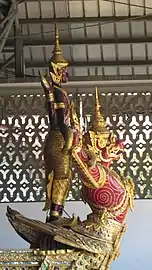 The bow of Royal Barge Narai Song Suban HM Rama IX of Thailand, it carved a image of Narayana ride a Garuda
The bow of Royal Barge Narai Song Suban HM Rama IX of Thailand, it carved a image of Narayana ride a Garuda.jpg.webp) Idol of Narayana around 14/15th century, found at the Devasathan, inner Bangkok, Thailand
Idol of Narayana around 14/15th century, found at the Devasathan, inner Bangkok, Thailand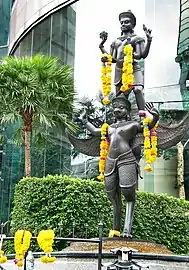 Idol of Narayana ride a Garuda built in Khmer art style in front of InterContinental Bangkok, Phloen Chit Road, it is one of the most respected Hindu shrines in the Ratchaprasong neighbourhood alike Erawan Shrine
Idol of Narayana ride a Garuda built in Khmer art style in front of InterContinental Bangkok, Phloen Chit Road, it is one of the most respected Hindu shrines in the Ratchaprasong neighbourhood alike Erawan Shrine Drawing of sleeping Narayana on Sheshanaga while the four-headed Brahma springs from his navel
Drawing of sleeping Narayana on Sheshanaga while the four-headed Brahma springs from his navel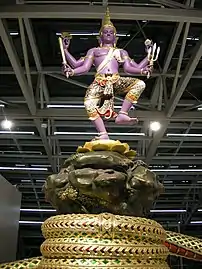 Statue of Narayana in Thai art style stands on Mount Mandara within Suvarnabhumi Airport, Samut Prakan, Thailand
Statue of Narayana in Thai art style stands on Mount Mandara within Suvarnabhumi Airport, Samut Prakan, Thailand.jpg.webp) Khmer lintel depicting Narayana sleeping upon the Sheshanaga in the middle of Milky Ocean, Bangkok National Museum
Khmer lintel depicting Narayana sleeping upon the Sheshanaga in the middle of Milky Ocean, Bangkok National Museum
See also
References
- "॥ नारायणसूक्तम् सार्थ ॥ - .. Narayana Sukta .. - Sanskrit Documents". sanskritdocuments.org. Retrieved 21 October 2015.
- Narayan Aiyangar (1901). Essays on Indo Aryan Mythology. pp. 196.
- "The Laws of Manu I". www.sacred-texts.com. Retrieved 7 December 2019.
- "The Mahabharata, Book 3: Vana Parva: Markandeya-Samasya Parva: Section CLXXXVIII". www.sacred-texts.com. Retrieved 5 December 2019.
- "Monier-Williams Sanskrit-English Dictionary -- n". faculty.washington.edu. Retrieved 5 December 2019.
- Harivansh, Adhyay 88 shlock 44, also, Manu Smruti 1:10 " The Law Code of Manu", Published by Oxford University Press, ISBN 0-19-280271-2, page 11
- "Sanskrit Dictionary for Spoken Sanskrit: 'nara'". spokensanskrit.org. Retrieved 5 December 2019.
- "Sanskrit Dictionary for Spoken Sanskrit 'yana'". spokensanskrit.org. Retrieved 5 December 2019.
- Vaisnavism Saivism and Minor Religious Systems, Ramkrishna Gopal Bhandarkar. Published by Asian Educational Services, p.46.
- Hiltebeitel, Alf (1990). The ritual of battle: Krishna in the Mahābhārata. Albany, N.Y: State University of New York Press. ISBN 0-7914-0249-5. p61
- Prabhupada, AC Bhaktivedanta. "Bhagavad-gita As It Is Chapter 11 Verse 3". vedabase.net. Archived from the original on 15 May 2008. Retrieved 10 May 2008. "see the cosmic manifestation"
- "Archived copy". Archived from the original on 15 May 2007. Retrieved 21 May 2007.CS1 maint: archived copy as title (link)
- "SN 2.12: With Vishnu —Bhikkhu Sujato". SuttaCentral. Retrieved 25 December 2019.
- "那羅延". Digital Dictionary of Buddhism. 2009. Retrieved 25 December 2019.
- Giebel, Rolf W. (translator) (2005). The Vairocanābhisaṃbodhi Sūtra (PDF). BDK America, Inc.
- Roberts, Peter Alan; Tulku Yeshi (2013). "The Basket's Display". 84000: Translating the Words of the Buddha. Retrieved 25 December 2019.
- "Narayanastra – Defending Vaishnavism as the supreme Vedic position". narayanastra.blogspot.in. Retrieved 21 October 2015.
External links
| Wikimedia Commons has media related to Sheshasayi Vishnu. |
